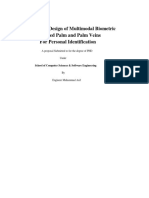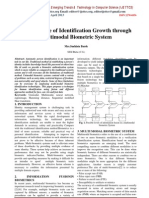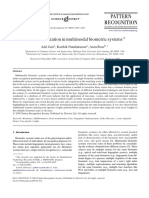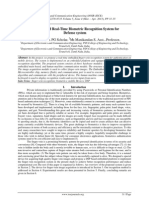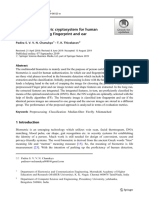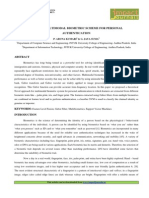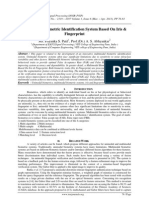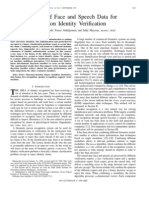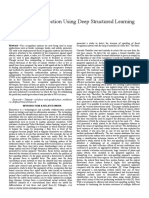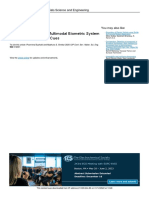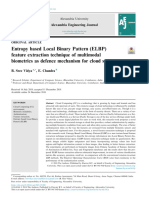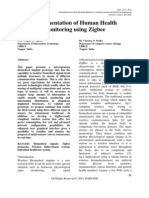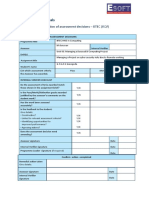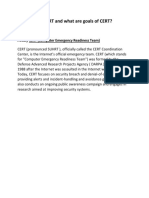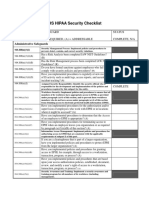Data Level Fusion For Multi Biometric System Using Face and Finger
Data Level Fusion For Multi Biometric System Using Face and Finger
Uploaded by
Ijarcsee JournalCopyright:
Available Formats
Data Level Fusion For Multi Biometric System Using Face and Finger
Data Level Fusion For Multi Biometric System Using Face and Finger
Uploaded by
Ijarcsee JournalOriginal Title
Copyright
Available Formats
Share this document
Did you find this document useful?
Is this content inappropriate?
Copyright:
Available Formats
Data Level Fusion For Multi Biometric System Using Face and Finger
Data Level Fusion For Multi Biometric System Using Face and Finger
Uploaded by
Ijarcsee JournalCopyright:
Available Formats
ISSN: 2277 9043 International Journal of Advanced Research in Computer Science and Electronics Engineering Volume 1, Issue 2, April
l 2012
DATA LEVEL FUSION FOR MULTI BIOMETRIC SYSTEM USING FACE AND FINGER
Shubhangi Sapkal Govt. College of Engineering, Aurangabad
Abstract In this work, most commonly used and accepted biometrics face and finger are used for data level fusion. Multi biometric systems are expected to improve population coverage, reduce spoofing and be resilient to fault tolerance of different mono modal biometric systems. This system is designed for access control system requires more security such as allow to access important data, it is the false acceptance rate that is major concern in such applications. We do not want to access the data even the risk of manually examining a large number of potential matches identified by the biometric system.
Index TermsMulti modal biometrics, Failure-to-enroll, Fusion
I. INTRODUCTION Multimodal biometric systems are those which utilize, or have capability of utilizing, more than one physiological or behavioral characteristic for enrollment, verification, or identification. The reason for combining different sensor modalities is to improve the recognition accuracy [1]. Unimodal biometric systems have to contend with a variety of problems such as noisy data, intra-class variations, restricted degrees of freedom, non-universality, spoof attacks, and unacceptable error rates. Some of these limitations can be addressed by deploying multimodal biometric systems that integrate the evidence presented by multiple sources of information [2]. For IDs application, multimodality may be an effective tool to reduce the Failure to Enroll (FTE) rate. The sequential use of multiple modalities guarantees that the non-enrollable population is reduced drastically. Furthermore, sequential use of modalities permits fair treatment of persons that do not possess a certain biometric trait [3]. Here two inexpensive and widely accepted biometric traits namely face and fingerprint is used. Human face recognition has a tremendous potential in a wide variety of commercial and law enforcement applications. Considerable research efforts have been devoted to the face recognition problem over the past decade. Although there are a number of face recognition algorithms which work well in constrained environments, face recognition is still an open and very challenging problem in real applications [4]. Biometrics has long been known as a robust approach for person authentication. However, most mono modal biometrics are proven to exhibit one or more weaknesses. Multi biometric systems combine the information presented
Manuscript received April 07, 2012. Shubhangi Sapkal, Computer Science and Engineering Department,Government College of Engineering, Aurangabad., India.
by multiple biometric sensors, algorithms, samples, units, or traits. In addition to improving recognition accuracy, these systems are expected to improve population coverage, reduce spoofing and be resilient to fault tolerance of different mono modal biometric systems [5]. Face recognition is a nonintrusive method, and facial images are probably the most common biometric characteristic used by humans to make personal recognition. It is questionable whether the face itself, without any contextual information, is a sufficient basis for recognizing a person from a large number of identities with an extremely high level of confidence. Humans have used fingerprints for personal identification from many decades. But, fingerprints of a small fraction of the population may be unsuitable for the automatic identification because of genetic factors, aging, environmental, or occupational reasons (e.g., manual workers may have a large number of cuts and bruises on their fingerprints that keep changing) [6] . The initial idea and early work of this research have been published in part as conference papers in [7], [8], [9]. The outline of the work is as follows. Section 2 discusses approaches presented in the literature. Section 3 deals with image fusion. Section 4 extends to modes of operations. Section 5 discusses on Wavelet Transform and Decomposition. Section 6 contains similarity Measures. Experimental results are given in section 7. Finally conclusions are drawn in section 8.
II. RELATED RESEARCH ON MULTIMODAL BIOMETRICS In [10], the data level fusion is used and the DWT coefficients are selected as features and the image is reconstructed with those features. Miguel Carrasco in [11] proposed a bimodal identification system that combines face and voice information. A probabilistic fusion scheme at the matching score level is used, which linearly weights the classification probabilities of each person-class from both face and voice classifiers. In [12], histogram equalization of biometric score distribution is successfully applied in a multimodal person verification system composed by prosodic, speech spectrum and face information. Furthermore, a new bi-Gaussian equalization (BGEQ) is introduced. Stephen J. Elliott in [13], outlines the perceptions of 391 individuals on issues relating to biometric technology. Results demonstrated overwhelming support for biometrics applications involving law enforcement and obtaining passports, while applications involving time and attendance tracking and access to public schools ranked lowest on the list. A bimodal biometric verification system based on k-Nearest Neighbourhood (k-NN) classifiers in the decision fusion module for the face and speech experts is discussed in [14]. In [15], a method of speaker recognition is introduced based 80
All Rights Reserved 2012 IJARCSEE
ISSN: 2277 9043 International Journal of Advanced Research in Computer Science and Electronics Engineering Volume 1, Issue 2, April 2012
on multimodal biometrics by using the kernel fisher discriminant analysis. Micha Chora [16] proposed a system on the basis of ear, palm and lips images for human identification. The combination of iris and fingerprint biometrics is used in [17]. Jian Yang [18] proposed an unsupervised discriminant projection (UDP) technique for dimensionality reduction of high dimensional data in small sample size cases. UDP can be seen as a linear approximation of a multimanifolds-based learning framework which takes into account both the local and nonlocal quantities. The method is applied to face and palm biometrics and is examined using the Yale, FERET, and AR face image databases. M. K. Shahin, A. M. Badawi Proposed in [19] three biometric modalities for validating and implementing multimodal biometric system, that are hand vein, hand geometry and fingerprint.
biometric characteristics do not have to be acquired simultaneously. Further, a decision could be arrived at without acquiring all of the traits. This reduces the overall recognition time. In the hierarchical scheme, individual classifiers are combined in a treelike structure. This work used parallel mode for fusion of face and finger. V.
WAVELET TRANSFORM
III. IMAGE FUSION The three possible levels of fusion are: fusion at the feature extraction or data level [20], fusion at the matching score level [21] , [22], [23] [24], [25] and fusion at the decision level [26], [27], [28]. (a) Fusion at the data or feature level: Either the data itself or the feature sets originating from multiple sensors/sources are fused [2]. The data obtained from each sensor is used to compute a feature vector. As the features extracted from one biometric trait are independent of those extracted from the other, it is reasonable to concatenate the two vectors into a single new vector. The new feature vector now has a higher dimensionality and represents a persons identity in a different hyperspace. Feature reduction techniques may be employed to extract useful features from the larger set of features. (b) Fusion at the matching score level: Each system provides a matching score indicating the proximity of the feature vector with the template vector. These scores can be combined to assert the veracity of the claimed identity. (3) Fusion at the decision level: Each sensor can capture multiple biometric data and the resulting feature vectors individually classified into the two classesaccept or reject. A majority vote scheme can be used to make the final decision [22]. IV.
MODES OF OPERATION
The biometrics image fusion extracts information from each source image and obtains the effective representation in the final fused image [29]. The aim of image fusion technique is to process the fusing detailed information which obtains from both the source images. The multi-resolution image used to represent the signals where decomposition is performed for obtaining finer detail. Multi-resolution image decomposition gives an approximation image and three other images viz., horizontal, vertical and diagonal images of coarse detail. The face and fingerprint images are obtained from different sources. After re-scaling, the images are fused by using wavelet transform and decomposition. Finally, we obtain a completely new fused image, where both the attributes of face and fingerprint images are focused and reflected. The proposed image fusion rule selects the larger absolute values of the two wavelet coefficients at each point. Therefore, a fused image is produced by performing an inverse wavelet transform based on integration of wavelet coefficients correspond to the decomposed face and fingerprint images. More formally, wavelet transform decomposes an image recursively into several frequency levels and each level contains transform values. Finally, inverse wavelet transformation is performed to restore the fused image. The fused image possesses good quality of relevant information for face and fingerprint images. In this work daubechies2 (Fig. 2) wavelet family for decomposition (Fig. 1) is used.
A multi biometric system can operate in one of three different modes: serial mode, parallel mode, or hierarchical mode[6]. In the serial mode of operation, the output of one biometric trait is typically used to narrow down the number of possible identities before the next trait is used. This serves as an indexing scheme in an identification system. For example, a multi biometric system using face and fingerprints could first employ face information to retrieve the top few matches, and then use fingerprint information to converge onto a single identity. This is in contrast to a parallel mode of operation where information from multiple traits is used simultaneously to perform recognition. This difference is crucial. In the cascade operational mode, the various
Fig. 1: Wavelet decomposition
81
All Rights Reserved 2012 IJARCSEE
ISSN: 2277 9043 International Journal of Advanced Research in Computer Science and Electronics Engineering Volume 1, Issue 2, April 2012
Fig 2: A daubechies 2 wavelet VI.
EXPERIMENTAL EVALUATION
Threshold FRR FAR 0.14 0 0.6 0.32 0 0.65 0.44 0 0.7 0.56 0 0.75 0.75 0 0.8 0.87 0 0.85 Table 1: Recognition performance for different threshold values using MEAN fusion technique Threshold FRR FAR 0.34 0.21 0.6 0.4 0.19 0.65 0.43 0.07 0.7 0.61 0 0.75 0.79 0 0.8 0.88 0 0.85 Table 2: Recognition performance for different threshold values using MAX-MIN fusion technique
A typical biometric recognition system commits two types of errors: false acceptance and false rejection; a distinction has to be made between positive and negative recognition; in positive recognition systems (e.g., an access control system) a false match determines the false acceptance of an impostor, whereas a false non-match causes the false rejection of a genuine user. On the other hand, in a negative recognition application (e.g., preventing users from obtaining welfare benefits under false identities), a false match results in rejecting a genuine request, whereas a false non-match results in falsely accepting an impostor attempt. The notation false match/false non-match is not application dependent and therefore, in principle, is preferable to false acceptance/false rejection. However, the use of false acceptance rate (FAR) and false rejection rate (FRR) is more popular and largely used in the commercial environment [31]. Positive recognition system is considered in this work and correlation is used as similarity measure. FRR is False Rejection Ratio, which means the fault when someone which registered in the system was refused by system [33]. Table I presents the FRR values of genuine person faces. FAR is False Acceptance Rate, which is the fault where someone of user which does not enlist will be held true by the system. FAR values for impostor persons are presented in Table II. Finally, Table III presents the FAR and FRR values for all persons with different threshold values. The FRR and FAR for number of participants (N) are calculated as specified in Eq. (1) and in equation Eq. (2):
1N FRR FRR () n (1) N1 n
Graph 1: - FAR-FRR diagram for MEAN method
Graph 2: - FAR-FRR diagram for MAX-MIN method VII.
CONCLUSION
1N FAR FAR ) () n(2 N1 n
A 2D Discrete Wavelet Transform is proposed to capture the characteristics in faces and fingerprints. Experimental results on an extensive set of face (FETRET database) and fingerprint database (FVC-2004 database) demonstrate that the proposed correlation and wavelet method outperforms in identification. It is shown that the proposed method gives satisfying results for threshold-0.7. There is a trade-off between FAR
82
All Rights Reserved 2012 IJARCSEE
ISSN: 2277 9043 International Journal of Advanced Research in Computer Science and Electronics Engineering Volume 1, Issue 2, April 2012
and FRR values. In some access control system with more security such as allow to access some important data, it is the false acceptance rate that is major concern that is, we do not want to access the data even the risk of manually examining a large number of potential matches identified by the biometric system. Result shows that FAR is 0, which can be applied in such applications. This work can be extended to feature level fusion to improve accuracy and robustness.
References [1] Satyanadh Gundimada and Vijayan K. Asari, Facial Recognition Using Multisensor Images Based on Localized Kernel Eigen Spaces, IEEE Transactions on Image Processing, Vol. 18, No. 6, PP. 1314-1325, June 2009 [2] Arun Ross and Anil K. Jain, Multimodal Biometrics: An Overview, Proc. of 12th European Signal Processing Conference (EUSIPCO), pp. 1221-1224, September 2004. [3] Damien Dessimoz, Jonas Richiardi, Christophe Champod, Andrzej Drygajlo, Multimodal biometrics for identity documents, Forensic Science International 167, pp. 154159, 2007. [4] Xiaoguang Lu, Yunhong Wangy, Anil K. Jain, Combining Classifiers For Face Recognition [5] Mohamed Deriche, Trends and Challenges in Mono and Multi Biometrics, Image Processing Theory, Tools & Applications, 2008 IEEE. [6] Anil K. Jain, Arun Ross, and Sharath Pankanti, Biometrics: A Tool for Information Security, IEEE Transactions on Information Forensics And Security, Vol. 1, No. 2, pp. 125-143, June 2006. [7] S.D. Sapkal, S.N. Kakarwal, P.S. Revankar, Image classification using neural network, Proc. Of International conf. ICSCI, pp. 259-263, 2007. [8] S.D. Sapkal, S.N. Kakarwal, M.D. Malkauthekar, Classification of facial images using FFNN, Proc. Of International conf. ICACT, pp.435-438, 2008. [9]S.D. Sapkal, S.N. Kakarwal, Image enhancement and Feature Extraction for Fingerprint Images: A Review, National conf. MIT Aurangabad, pp. 04. [10] Satyanadh Gundimada and Vijayan K. Asari, Facial Recognition Using Multisensor Images Based on Localized Kernel Eigen Spaces, IEEE Transactions on Image Processing, Vol. 18, No. 6, pp. 1314-1325, June 2009. [11] Miguel Carrasco, Luis Pizarro and Domingo Mery, Bimodal Biometric Person Identification System Under Perturbations, Springer, pp. 114127, 2007. [12] P. Ejarque J. Hernando, Score bi-Gaussian equalisation for multimodal person verification, IET Signal Process., Vol. 3, Iss. 4, pp. 322332, 2009. [13] Stephen J. Elliott, Sarah A. Massie, Mathias J. Sutton, The Perception of Biometric Technology: A Survey, pp. 259-264, 2007 IEEE. [14] Andrew Teoh, S. A. Samad and A. Hussain, Nearest Neighbourhood Classifiers in a Bimodal Biometric Verification System Fusion Decision Scheme, Journal of Research and Practice in Information Technology, Vol. 36, No. 1, pp. 47-62 February 2004.
[15] Masatsugu Ichino, Hitoshi Sakano and Naohisa Komatsu , Multimodal Biometrics of Lip Movements and Voice using Kernel Fisher Discriminant Analysis ,ICARCV 2006 IEEE [16] Micha Chora, Emerging Methods of Biometrics Human Identification, 2007 IEEE. [17] Stelvio Cimato, Marco Gamassi, Vincenzo Piuri, Roberto Sassi and Fabio Scotti, Privacy-aware Biometrics: Design and Implementation of a Multimodal Verification System, 2008 Annual Computer Security Applications Conference, 2008 IEEE pp. 130-139. [18] Jian Yang, David Zhang, Jing-yu Yang, and Ben Niu, Globally Maximizing, Locally Minimizing: Unsupervised Discriminant Projection with Applications to Face and Palm Biometrics, IEEE Transactions on Pattern Analysis And Machine Intelligence, pp.650-664, 2007. [19] M. K. Shahin, A. M. Badawi, M. E. Rasmy, A Multimodal Hand Vein, Hand Geometry, And Fingerprint Prototype Design For High Security Biometrics, CIBEC'08, 2008 IEEE. [20] A. Rattani, D. R. Kisku, M. Bicego, and M. Tistarelli, Feature Level Fusion of Face and Fingerprint Biometrics, 2007 IEEE. [21] Norman Poh, Thirimachos Bourlai and Josef Kittler, BioSecure DS2: A Score-level Quality-dependent and Cost-sensitive Multimodal Biometric Test Bed [22] Arun Ross, Anil Jain, Information fusion in biometrics, Pattern Recognition Letters 24, pp. 21152125, 2003. [23] F. Wang and J. Han, Multimodal biometric authentication based on score level fusion using support vector machine, OptoElectronics Review 17(1), pp. 5964 [24] Ajay Kumar, Vivek Kanhangad, David Zhang, Multimodal Biometrics Management Using Adaptive Score-Level Combination, 2008 IEEE. [25] Robert Snelick, Umut Uludag, Alan Mink, Michael Indovina, and Anil Jain, Large-Scale Evaluation of Multimodal Biometric Authentication Using State-of-the-Art Systems, IEEE Transactions on Pattern Analysis And Machine Intelligence, Vol. 27, pp. 450-455, March 2005. [26] Kar-Ann Toh, Xudong Jiang, and Wei-Yun Yau, Exploiting Global and Local Decisions for Multimodal Biometrics Verification, IEEE Transactions On Signal Processing, Vol. 52, No. 10, pp. 3059-3072, October 2004. [27] Kar-Ann Toh,er, and Wei-Yun Yau, Combination of Hyperbolic Functions for Multimodal Biometrics Data Fusion, IEEE Transactions on Systems, Man, And CyberneticsPart B: Cybernetics, Vol. 34, pp. 1196-1209, April 2004. [28] Kalyan Veeramachaneni, Lisa Ann Osadciw, and Pramod K. Varshney, An Adaptive Multimodal Biometric Management Algorithm, IEEE Transactions on Systems, Man, And CyberneticsPart C: Applications And Reviews, Vol. 35, No. 3, pp. 344-356, August 2005. [29] Dakshina Ranjan Kisku, Ajita Rattani, Phalguni Gupta, Jamuna Kanta Sing, Biometric Sensor Image Fusion for Identity Verification: A Case Study with Wavelet-based Fusion Rules and Graph Matching, 2009 IEEE, pp. 436-439. [30] Arjun V. Mane, Ramesh R. Manza, Karbhari V. Kale,The Role of Similarity Measures in Face Recognition, 83
All Rights Reserved 2012 IJARCSEE
ISSN: 2277 9043 International Journal of Advanced Research in Computer Science and Electronics Engineering Volume 1, Issue 2, April 2012
International Journal of Computer Science and Application, Issue-I, pp. 62-65, 2010. [31] Davide Maltoni, Dario Maio, Anil K. Jain, Salil Prabhakar, Handbook of Fingerprint Recognition(Springer), pp 3. [32] Neil Yager and Ted Dunstone, The Biometric Menagerie, IEEE Transactions On Pattern Analysis And Machine Intelligence, VOL. 32, NO. 2, FEBRUARY 2010, 220-230. [33] Website: http://www.bromba.com/faq/biofaqe
84
All Rights Reserved 2012 IJARCSEE
You might also like
- DIGOO DG-Series User ManualDocument17 pagesDIGOO DG-Series User ManualLoon K50% (2)
- Identification of Safety Critical Equipment (SCE) : GuideDocument28 pagesIdentification of Safety Critical Equipment (SCE) : Guidemoustafa100% (2)
- Research ProposalDocument16 pagesResearch ProposalMuhammad AsifNo ratings yet
- How Nutanix Works EbookDocument40 pagesHow Nutanix Works EbookM.Usman Safdar100% (4)
- 16 - 17 March 2012 1331701306P047 Multimodal Biometric System Using Face and Signature A Score Level Fusion ApproachDocument5 pages16 - 17 March 2012 1331701306P047 Multimodal Biometric System Using Face and Signature A Score Level Fusion Approachडॉ.मझहर काझीNo ratings yet
- (IJCT-V2I4P12) Authtors :swapnali G. Garud, Ravindra A. NikamDocument6 pages(IJCT-V2I4P12) Authtors :swapnali G. Garud, Ravindra A. NikamIjctJournalsNo ratings yet
- Review of Multimodal BiometricDocument4 pagesReview of Multimodal BiometricEditor IJRITCCNo ratings yet
- Implementation of Unimodal To Multimodal Biometric Feature Level Fusion of Combining Face Iris and Ear in Multi-Modal Biometric SystemDocument5 pagesImplementation of Unimodal To Multimodal Biometric Feature Level Fusion of Combining Face Iris and Ear in Multi-Modal Biometric SystemInternational Journal of Scholarly ResearchNo ratings yet
- Mean-Discrete Algorithm For Individuality RepresentationDocument10 pagesMean-Discrete Algorithm For Individuality RepresentationBayan OmarNo ratings yet
- A Certificate of Identification Growth Through Multimodal Biometric SystemDocument5 pagesA Certificate of Identification Growth Through Multimodal Biometric SystemInternational Journal of Application or Innovation in Engineering & ManagementNo ratings yet
- Score Normalization in Multimodal Biometric SystemsDocument16 pagesScore Normalization in Multimodal Biometric Systemsatelie 2No ratings yet
- Multi-Block Color-Binarized Statistical Images For Single Sample Face RecognitionDocument21 pagesMulti-Block Color-Binarized Statistical Images For Single Sample Face RecognitionAzeddine AISSAOUINo ratings yet
- YMER2110G8Document11 pagesYMER2110G8abhisheksurendran75No ratings yet
- An Embedded Real-Time Biometric Recognition System For Defense SystemDocument5 pagesAn Embedded Real-Time Biometric Recognition System For Defense SystemInternational Organization of Scientific Research (IOSR)No ratings yet
- Multispectral Palmprint Recognition Using Wavelet-Based Image FusionDocument8 pagesMultispectral Palmprint Recognition Using Wavelet-Based Image Fusionsaran52_eceNo ratings yet
- Multimodal Biometric Cryptosystem For Human Authentication Using Fingerprint and EarDocument15 pagesMultimodal Biometric Cryptosystem For Human Authentication Using Fingerprint and EaraftermathaftermathNo ratings yet
- A Bimodal Biometric Student Attendance SystemDocument8 pagesA Bimodal Biometric Student Attendance SystemJose Hernandez PalancarNo ratings yet
- Information Fusion in BiometricsDocument6 pagesInformation Fusion in BiometricsMeenakshi Nehra PooniaNo ratings yet
- Eng-A Novel Multimodal Biometric Scheme-P. Aruna KumariDocument12 pagesEng-A Novel Multimodal Biometric Scheme-P. Aruna KumariImpact JournalsNo ratings yet
- Fast Multimodal Biometric Approach Using Dynamic Fingerprint Authentication and Enhanced Iris FeaturesDocument45 pagesFast Multimodal Biometric Approach Using Dynamic Fingerprint Authentication and Enhanced Iris FeaturesShruti SharmaNo ratings yet
- 2006 MMUA FingerprNormQ AlonsoDocument8 pages2006 MMUA FingerprNormQ Alonsolmtp80No ratings yet
- Vu Watermarking MultimodalDocument9 pagesVu Watermarking MultimodallabbasmohammedamineNo ratings yet
- A Survey On Protecting Privacy Using Biometric of Fingerprint CombinationDocument3 pagesA Survey On Protecting Privacy Using Biometric of Fingerprint CombinationseventhsensegroupNo ratings yet
- Feature-Level Fusion in Personal IdentificationDocument6 pagesFeature-Level Fusion in Personal IdentificationpreethynrkNo ratings yet
- A Face Recognition Attendance System With GSM NotificationDocument6 pagesA Face Recognition Attendance System With GSM Notificationmodena tigaNo ratings yet
- Multimodal Biometric Identification System Based On Iris & FingerprintDocument8 pagesMultimodal Biometric Identification System Based On Iris & FingerprintInternational Organization of Scientific Research (IOSR)No ratings yet
- Face Liveness Detection: Department of ECE CmrcetDocument15 pagesFace Liveness Detection: Department of ECE CmrcetShekar ReddyNo ratings yet
- Overviewoffaceliveness PaperDocument16 pagesOverviewoffaceliveness PaperEc Alwin jollyNo ratings yet
- Paper 22-An Adaptive Multimodal BiometriDocument8 pagesPaper 22-An Adaptive Multimodal BiometrieshwarirajNo ratings yet
- Real-Time Surveillance Through Face Recognition UsDocument9 pagesReal-Time Surveillance Through Face Recognition UsfluidjNo ratings yet
- Deep Learning Detection of Facial Biometric Presentation AttackDocument18 pagesDeep Learning Detection of Facial Biometric Presentation AttackIshika JainNo ratings yet
- Fusion of Face and Speech Data For Person Identity VerificationDocument10 pagesFusion of Face and Speech Data For Person Identity VerificationMarco LeottaNo ratings yet
- Personal Authentication Using 3 D Finger GeometryDocument10 pagesPersonal Authentication Using 3 D Finger GeometryShabeer VpkNo ratings yet
- SOM and PCA Approach For Face Recognition - A SurveyDocument6 pagesSOM and PCA Approach For Face Recognition - A Surveysurendiran123No ratings yet
- Conference FACE SPOOFDocument5 pagesConference FACE SPOOFDIVYA MNo ratings yet
- Face Spoof Detection Using Deep Structured Learning: Abstract-Face Recognition Systems Are Now Being Used in ManyDocument5 pagesFace Spoof Detection Using Deep Structured Learning: Abstract-Face Recognition Systems Are Now Being Used in ManydivyaNo ratings yet
- El Abed2011Document8 pagesEl Abed2011Kamel GhanemNo ratings yet
- Ijerph 19 04719 v2Document6 pagesIjerph 19 04719 v2ade apriediNo ratings yet
- Elbeqqal 2018Document9 pagesElbeqqal 2018Dickson Scott Rosales CanoNo ratings yet
- 2022 Art FosousaDocument21 pages2022 Art FosousajhonsmithertNo ratings yet
- Chapter 1: Introduction: 1.1 BiometricsDocument10 pagesChapter 1: Introduction: 1.1 BiometricsAnkur KumarNo ratings yet
- An Approach For Full Reinforcement-Based Biometric Score FusionDocument13 pagesAn Approach For Full Reinforcement-Based Biometric Score FusionScience DirectNo ratings yet
- Byahatti 2020 IOP Conf. Ser. Mater. Sci. Eng. 925 012031Document10 pagesByahatti 2020 IOP Conf. Ser. Mater. Sci. Eng. 925 012031Elham SedighiNo ratings yet
- Hand Biometrics: Erdem Yo Ru K, Helin Dutag Aci, Bu Lent SankurDocument15 pagesHand Biometrics: Erdem Yo Ru K, Helin Dutag Aci, Bu Lent Sankurjit_72No ratings yet
- PDF/JCSSP 2012 431 435Document5 pagesPDF/JCSSP 2012 431 435jit_72No ratings yet
- BiometricDocument11 pagesBiometricManikandan MurugesanNo ratings yet
- Biometrics An Evolving Industry With Unique RisksDocument7 pagesBiometrics An Evolving Industry With Unique RisksIJRASETPublicationsNo ratings yet
- Score Fusion of Finger Vein and Face For Human Recognition Based On Convolutional Neural Network ModelDocument9 pagesScore Fusion of Finger Vein and Face For Human Recognition Based On Convolutional Neural Network ModelFressy NugrohoNo ratings yet
- Robust Biometrics Based On PalmprintDocument9 pagesRobust Biometrics Based On PalmprintInternational Journal of Application or Innovation in Engineering & ManagementNo ratings yet
- 12051-Article Text-21404-1-10-20220201Document10 pages12051-Article Text-21404-1-10-20220201lutfia hajNo ratings yet
- MACE Correlation Filter Algorithm For Face Verification in Surveillance ScenarioDocument10 pagesMACE Correlation Filter Algorithm For Face Verification in Surveillance ScenarioJournal of Computer Science and EngineeringNo ratings yet
- An Efficient Android-Based Multimodal Biometric Authentication System With Face and VoiceDocument17 pagesAn Efficient Android-Based Multimodal Biometric Authentication System With Face and VoiceJust HereNo ratings yet
- Research Paper For VipIMAGE Portugal 2017Document15 pagesResearch Paper For VipIMAGE Portugal 2017Arslan RasheedNo ratings yet
- Graph Fusion Using Finger Print RecognitionDocument9 pagesGraph Fusion Using Finger Print RecognitionAnu AntonyNo ratings yet
- An Embedded Finger Vein Recognition SystemDocument5 pagesAn Embedded Finger Vein Recognition SystemInternational Journal of Research in Engineering and TechnologyNo ratings yet
- Writer-Independent Offline Signature Verification Using Deep LearningDocument7 pagesWriter-Independent Offline Signature Verification Using Deep LearningIJRASETPublicationsNo ratings yet
- Applsci 13 00659Document13 pagesApplsci 13 00659bramhasayanNo ratings yet
- Entropy Based Local Binary Pattern ELBP Feature Extracti 2019 Alexandria EDocument12 pagesEntropy Based Local Binary Pattern ELBP Feature Extracti 2019 Alexandria ESoumitra DasNo ratings yet
- Multimodal Biometric Crypto System For Human AutheDocument11 pagesMultimodal Biometric Crypto System For Human Authetech guruNo ratings yet
- Refer For FusionDocument7 pagesRefer For FusionSumaLathaNo ratings yet
- Face Recognition: A Literature Review: A. S. Tolba, A.H. El-Baz, and A.A. El-HarbyDocument16 pagesFace Recognition: A Literature Review: A. S. Tolba, A.H. El-Baz, and A.A. El-HarbyMarta FloresNo ratings yet
- Study On Advancement in Face Recognition Technology: Arpit Arora, Abhishek KR - Rai, DR - Leena AryaDocument4 pagesStudy On Advancement in Face Recognition Technology: Arpit Arora, Abhishek KR - Rai, DR - Leena AryaRavindra KumarNo ratings yet
- Full-Reference Metric For Image Quality Assessment: Abstract-The Quality of Image Is Most Important Factor inDocument5 pagesFull-Reference Metric For Image Quality Assessment: Abstract-The Quality of Image Is Most Important Factor inIjarcsee JournalNo ratings yet
- Modified Pointwise Shape-Adaptive DCT For High-Quality Deblocking of Compressed ImagesDocument7 pagesModified Pointwise Shape-Adaptive DCT For High-Quality Deblocking of Compressed ImagesIjarcsee JournalNo ratings yet
- Design and Simulation of 1-Bit Sigma-Delta ADC Using Ngspice ToolDocument5 pagesDesign and Simulation of 1-Bit Sigma-Delta ADC Using Ngspice ToolIjarcsee JournalNo ratings yet
- Energy Efficient Clustering and Routing Techniques For Wireless Sensor NetworksDocument5 pagesEnergy Efficient Clustering and Routing Techniques For Wireless Sensor NetworksIjarcsee JournalNo ratings yet
- Attack Detection by Clustering and Classification Approach: Ms. Priyanka J. Pathak, Asst. Prof. Snehlata S. DongreDocument4 pagesAttack Detection by Clustering and Classification Approach: Ms. Priyanka J. Pathak, Asst. Prof. Snehlata S. DongreIjarcsee JournalNo ratings yet
- Self Organizing Markov Map For Speech and Gesture RecognitionDocument5 pagesSelf Organizing Markov Map For Speech and Gesture RecognitionIjarcsee JournalNo ratings yet
- Implementation of Human Health Monitoring Using ZigbeeDocument4 pagesImplementation of Human Health Monitoring Using ZigbeeIjarcsee JournalNo ratings yet
- Analysis of Voip Traffic in Wimax Using Ns2 Simulator: Pranita D. Joshi, Prof. Smita JangaleDocument6 pagesAnalysis of Voip Traffic in Wimax Using Ns2 Simulator: Pranita D. Joshi, Prof. Smita JangaleIjarcsee JournalNo ratings yet
- Implementation of Protocol For Efficient Data Storage and Data Dissemination in VANETDocument7 pagesImplementation of Protocol For Efficient Data Storage and Data Dissemination in VANETIjarcsee JournalNo ratings yet
- Sentiment Analysis and Influence Tracking Using TwitterDocument8 pagesSentiment Analysis and Influence Tracking Using TwitterIjarcsee JournalNo ratings yet
- Brain Segmentation Using Fuzzy C Means Clustering To Detect Tumour RegionDocument6 pagesBrain Segmentation Using Fuzzy C Means Clustering To Detect Tumour RegionIjarcsee JournalNo ratings yet
- Light Wieght Authentication System and Resource Monitoirng Using MASDocument5 pagesLight Wieght Authentication System and Resource Monitoirng Using MASIjarcsee JournalNo ratings yet
- A Study On Angle Stability Solution Using Coordinated Facts DevicesDocument5 pagesA Study On Angle Stability Solution Using Coordinated Facts DevicesIjarcsee JournalNo ratings yet
- UntitledDocument52 pagesUntitledbrennand_77No ratings yet
- Tra Disclosure: To Assist Them in Evaluating ApplicationsDocument1 pageTra Disclosure: To Assist Them in Evaluating ApplicationsCamilo CoronilNo ratings yet
- Email Solution For Enhancement of E-Mail Service PDFDocument4 pagesEmail Solution For Enhancement of E-Mail Service PDFResearch Journal of Engineering Technology and Medical Sciences (RJETM)No ratings yet
- ErrorDocument26 pagesErrorShashi WaghNo ratings yet
- Division Operations, Fmi 3-91 Draft - Feb 06Document306 pagesDivision Operations, Fmi 3-91 Draft - Feb 06msrpsrNo ratings yet
- Procedure To Formatting Hard Disk DUWDocument9 pagesProcedure To Formatting Hard Disk DUWCda SitiNo ratings yet
- Processing Integrity and Availability ControlsDocument10 pagesProcessing Integrity and Availability ControlsfitriaNo ratings yet
- 2013 Weapons Systems Modernization Priorities - 0Document230 pages2013 Weapons Systems Modernization Priorities - 0Herminio CerqueiraNo ratings yet
- Zte Ix350 Wimax Modem Spec v1.1Document18 pagesZte Ix350 Wimax Modem Spec v1.1Ramiz RzaogluNo ratings yet
- Datastage Administrator and Director - Day 1Document53 pagesDatastage Administrator and Director - Day 1mukesh50% (2)
- Traffic Sign Recognition Using MatLabDocument21 pagesTraffic Sign Recognition Using MatLabamiry1373No ratings yet
- Outline of The Body of Knowledge (Bok) For The Certified Information Privacy Manager (Cipm)Document7 pagesOutline of The Body of Knowledge (Bok) For The Certified Information Privacy Manager (Cipm)MatthewNo ratings yet
- MSCP AssignmentDocument55 pagesMSCP AssignmentSadeep SanchanaNo ratings yet
- OpenScape Business V2 Security ChecklistDocument50 pagesOpenScape Business V2 Security ChecklistMostafa SalehiNo ratings yet
- GPS Tracker Watch Supplier ManualDocument11 pagesGPS Tracker Watch Supplier Manualmmlipu.iosNo ratings yet
- Das 2016 Ijca 909789Document4 pagesDas 2016 Ijca 909789Vishal FundingNo ratings yet
- Q.1) What Is CERT and What Are Goals of CERT?: CERT (Computer Emergency Readiness Team)Document1 pageQ.1) What Is CERT and What Are Goals of CERT?: CERT (Computer Emergency Readiness Team)Vikas KumarNo ratings yet
- JWT Handbook PDFDocument106 pagesJWT Handbook PDFZoltán BalázsNo ratings yet
- Good Emails - CorpDocument115 pagesGood Emails - CorpNicolas LopezNo ratings yet
- Dmitriy Kovshun: LocatorDocument1 pageDmitriy Kovshun: LocatorAndry GlinskiyNo ratings yet
- Manual Biometrico OA 180Document91 pagesManual Biometrico OA 180Luis Morán0% (1)
- Barclays Statement Re Purchase of CA by Steve Young Financial DirectorDocument5 pagesBarclays Statement Re Purchase of CA by Steve Young Financial Directorlistings4475No ratings yet
- International Standard: Security and Resilience - Security Management Systems - RequirementsDocument33 pagesInternational Standard: Security and Resilience - Security Management Systems - Requirementsiam pheing80% (5)
- Sample Sebk100750 Sap Isu Fica Conf v1Document26 pagesSample Sebk100750 Sap Isu Fica Conf v1Sai ParekhNo ratings yet
- IHS HIPAA Security ChecklistDocument4 pagesIHS HIPAA Security ChecklistJared NyakambaNo ratings yet
- Proforma and Formal Way of Writing Letter For CompanyDocument5 pagesProforma and Formal Way of Writing Letter For CompanyDahabeshaNo ratings yet
- West Bengal Ration Card Form 6Document2 pagesWest Bengal Ration Card Form 6CHAUGACHHA DGSKNo ratings yet


